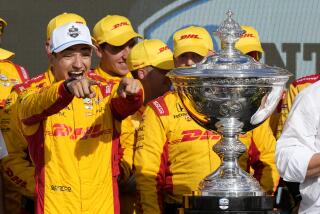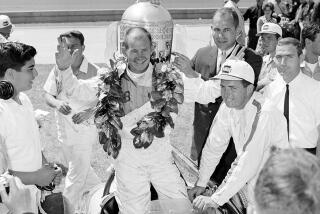JUDGMENT DAY
- Share via
INDIANAPOLIS — The drivers, engines and chassis aren’t the only things different in the Indianapolis 500 this year.
So are the questions.
In past years, the most-asked question in and around the Speedway was, “Who do you think will win the 500?”
Or maybe it would be, “Is it going to rain?”
For today’s historic 81st 500, the first under revolutionary Indy Racing League regulations, the almost universal question is, “How many cars do you think will finish the 500 miles?”
Or, “Do you think anyone will finish?”
What happens if no one makes 500 miles? Will it be like a Destruction Derby, the last one running wins?
Given the scarcity of engines, and the uncertainty over the reliability of the 35 that will be fired at 9 a.m. PDT, these are not idle questions.
Larry Curry, crew chief of the powerful Menard team of Tony Stewart and Robbie Buhl, said Friday in all seriousness, “I just hope the fans see cars running for 500 miles. It would be an embarrassment if the race ended at 435, or some other distance short of 500.”
How critical the situation is was illustrated Thursday during Carburetion Day--traditionally the last time cars and drivers can test their equipment before today’s race--when three cars of the Blueprint team, Phoenix winner Jim Guthrie, Sam Schmidt and Claude Bourbonnais, did not practice because they had no engines among them.
“We sent them out to be rebuilt and there was a problem on the dyno and we just didn’t get them back,” Guthrie said.
Because he felt it would be too dangerous to send cars out in the race with untested engines, chief steward Keith Ward permitted the three Blueprint team cars, plus Robby Gordon and Paul Durant, to test their systems for a few laps late Saturday afternoon. Gordon had a new engine installed after blowing one Thursday. No one took more than four laps and Guthrie’s 194 mph was fastest.
Gordon was left without a second engine because car owner Felix Sabates sold two of the team’s engines last Sunday so two other cars could get in the race.
There are other questions, such as, “What happened to the excitement?”
Business is down, and so is the electricity that once permeated the community. Even the corner of 16th Street and Georgetown Road, where once ticket hustlers and scalpers congregated, is relatively quiet. There is little need for them now because there are tickets available at the Speedway office.
According to the Indianapolis Convention and Visitors Assn., 48 of the 121 area hotels that routinely sell out Memorial Day weekend had vacancies as late as Friday.
“We’re lucky if we make $400 to $500 a day, when we used to clear $1,200 easy,” a sausage-stand operator next to the Speedway grounds said.
The malaise that has swept over the area is the result of the falling-out between CART teams, which include Al Unser Jr., Michael Andretti, Paul Tracy, Bobby Rahal and champion Jimmy Vasser, and the IRL. CART drivers have boycotted Indy the last two years.
The grandstand probably will look full today, with upward of 350,000 jamming the Speedway, but it won’t be the same. The “Greatest Spectacle in Racing” appears to have become nothing more than a spectacle.
Thirty-five cars, not the traditional 33, will start the race, a byproduct of the controversial IRL rule guaranteeing 25 of the 33 starting spots to teams running the IRL series. Cars qualified by Lyn St. James and Johnny Unser, non-IRL drivers, were bumped but when it was pointed out that they were faster than seven protected cars, executive director Leo Mehl ordered the field expanded.
“We didn’t want a situation where the fastest 33 cars were not in the race,” Mehl said.
It will be the first time since 1979 that more than 33 will start. In that year, a group of drivers who claimed they were unjustly denied a qualifying opportunity were given a second chance with the provision that no original qualifier could be bumped.
When Bill Vukovich Jr. and George Snider earned positions, they were added.
The change from turbocharged to normally aspirated engines has dramatically reduced speeds, which was one of the IRL’s original tenets.
Arie Luyendyk, the 1990 Indy winner who set a track qualifying record of 236.986 mph last year, will start on the pole today with a 218.263-mph speed. The field average is down 15.521 mph from last year’s record 227.807.
“We are very pleased at the speeds,” said Tony George, who founded the IRL last year after a long-running dispute with CART. “Running 250 and more on the straightaways and running race laps of 236, as happened last year, is unrealistic.”
In this year’s field, there is a disparity in speed between cars powered by Olds Aurora engines and the six with Nissan Infiniti power plants. When the difference--more than 8 mph between Luyendyk and the fastest Infiniti--became apparent early in the month, defending champion Buddy Lazier switched to Aurora.
“It was a difficult decision, but we felt we needed to give the defending champion the best opportunity we could,” car owner Ron Hemelgarn said. “We also had a commitment to Nissan to put two Infinitis in the field, and we did that.” St. James and Unser are in Hemelgarn cars.
“It was the cooperative atmosphere in the IRL that enabled us to get an Aurora engine. Stan Wattles had one on order from Brayton Engineering, but he hadn’t planned on racing at Indy, so he made his engine available to us.”
Even with the Aurora, however, Lazier managed only 214.286 and will start on the inside of the fourth row.
Up front with Luyendyk are Stewart, one of the pre-race favorites, and Vincenzo Sospiri, a Formula One refugee who has never raced on an oval track. Stewart, who has driven more laps at Indianapolis this year than anyone else, had practiced at close to 220 mph, but his official 218.021 fell just shy of Luyendyk.
“From now on, durability and not speed is the main consideration,” Stewart said. “We have run more than 600 miles on one engine, so we are happy with our building program. I have a lot of confidence in whatever [crew chief] Larry Curry puts in for [today].”
Scattered, from Sospiri down to Bourbonnais in the 11th row, there are 13 rookies, some with little or no experience in oval or superspeedway racing.
“There is always some concern with rookies, because you are not used to their driving characteristics,” said Luyendyk, rookie of the year in 1985. “On the other hand, I think there is too much emphasis placed on the fact they are rookies. Being a rookie at this place doesn’t mean you haven’t done a lot of racing.
“Some of these guys have shown they know how to race. Don’t forget, Nigel Mansell was a rookie here, and he was the world champion at the time. Sospiri has never been on an oval and he’s on the front row, but he’s driven Formula One. That’s good enough for me.”
Drivers may be dodging more than rookies today. Thunderstorms are predicted for this afternoon. For perhaps the first time in history, race officials may welcome rain--if the race has gone 101 laps, beyond the halfway mark.
That way, it would be official and we’d never know if there would be the embarrassment of not having a car complete the 500 miles.
*
RACE DAY
* WHEN: 8 a.m.
* TV: Channel 7
(BEGIN TEXT OF INFOBOX / INFOGRAPHIC)
Indianapolis Motor Speedway
(please see newspaper for full chart information)
INDIANAPOLIS 500
TRACK LENGTH: 2.5 miles
RACE LENGTH: 200 laps, 500 miles
DEFENDING CHAMP: Buddy Lazier
RACE RECORD: Arie Luyendyk, 185.981 mph, set 1990
QUALIFYING RECORD: Arie Luyendyk, 236.986 mph, set 1996
More to Read
Go beyond the scoreboard
Get the latest on L.A.'s teams in the daily Sports Report newsletter.
You may occasionally receive promotional content from the Los Angeles Times.










